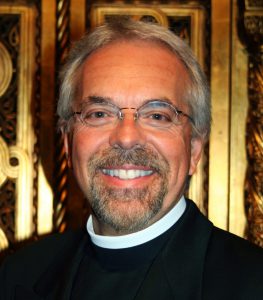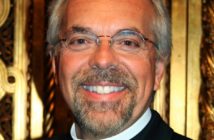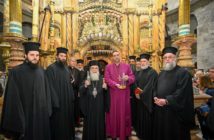
Fr Frank Marangos
Source: OINOS Educational Consulting
By Frank Marangos, D.Min., Ed.D., FCEP
Looking through binoculars while on expedition to a hard-to-reach location in the Alps, a group of botanists discovered a rare flower growing out of the side of a deep ravine. To successfully reach the exotic blossom, however, someone would have to carefully descend into the gorge. Noticing a local youngster standing nearby, the botanists asked if he would allow himself to be lowered with a rope along the side of the dangerous canyon. Excited, yet apprehensive about the venture, the boy peered thoughtfully into the chasm. “Wait,” he said, “I’ll be right back.” True to his word, the youngster returned accompanied by a much older man. “I’ll go over the cliff now,” said the lad, “but only if this man holds the rope. You see,” said the boy, “he’s the only one I trust . . . he’s my father!”Trust is the rope of shared governance. It is the firm administrative cord that helps trustees of theological schools and seminaries judiciously extend their respective reach. Shared governance, however, is a critical value of collaborative leadership that requires continued hard work, open communication, respect, and above all, trust. In fact, the stronger the confidence level of and for an institution’s board of trustees before a crisis, the better the chance that effective strategies will be wisely developed and prudently implemented.
The previous three parts of the commentary entitled,Transfiguring Theological Education, have utilized the General Standards of Accreditation (2017) published by the Association of Theological Schools in America (ATS) to help the nation’s theological schools and seminaries identify ways of overcoming the fiscal, administrative, and pedagogical challenges that currently threaten their survival. This essay will continue this pattern by examining how the implementation of shared governance can help nurture environments of institutional trust in which more effective and sustainable solutions can be advanced.
According to the Standard on Authority and Governance of the Association of Theological Schools in America (ATS), governance is an “institutional stewardship . . . and the responsibility of all, not just the governing board.” It is based on a “bond of trust among boards, administration, faculty, students, and ecclesial bodies.” As such, ATS recommends that each of its member institutions articulate “its own theologically informed understanding of how this bond of trust becomes operational as a form of shared governance.”
Governance has been a hallmark of colleges and universities in the United States since the early twentieth century. Governance is the means by which the nation’s institutions of higher education are formally organized, managed, and operated. While fundamental differences concerning the definition, structure, and application of governance among ecclesial educational institutions exist, research indicates, that when properly implemented, the shared governance model fosters the most favorable atmosphere for trustful relationships to develop.
Shared governance is a model of trusteeship in higher education that is based on the principle of distributed authority that links inclusiveness, creativity, and honest conversations. In a time of serious challenges, shared governance can be an essential institutional asset that can help trustees shift their thinking from parochial interests to more creative approaches for addressing tomorrow’s realities. But what are the characteristics of shared governance? And how can the nation’s institutions of higher theological education implement its valuable essentials?
The concept of shared governance first appeared in the 1960s when an often-cited document on the subject, Statement on Government of Colleges and Universities, was issued jointly by the American Association of University Professors, the American Council on Education, and the Association of Governing Boards of Universities and Colleges. Shared governance promised to increase collaboration, create useful links between constituencies, and build needed partnerships. It was a system that would guard against adopting models of governance that only emphasized fiduciary and utilitarian efforts.
Shared governance supports the collegial nature of theological education. In order for such a culture of trust to emerge, however, the ATS Commission on Accreditation specifically recommends that the unique and overlapping roles and responsibilities of the governing board, faculty, administrators, students, and other delegated authorities “be defined in a way that allows all partners to exercise their mandated or delegated leadership.” Furthermore, as governance is the ordered exercise of power that allows an institution to accomplish its’s mission and purpose, the Commission identifies three elements that are necessary for this power to be exercised in an orderly and trust-nurturing fashion: (1) authority, (2) structure, and (3) process.
Authority is defined by the 7th General Standard as “the exercise of rights, responsibilities, and powers accorded to a theological school by its charter, articles of incorporation and bylaws, and ecclesiastical and civil authorizations.” Structure, on the other hand, involves the various entities responsible for governing decisions, usually including the governing board, the administration, the faculty, and often student groups. Finally, effective governance requires a process by which the structure is ordered and implemented. Structure is effectively implemented only through carefully defined procedures that identify which group does what kind of work and how each group’s activity is coordinated with that of other groups.
In his article, Governance and the Future of Theological Education (2009), Daniel Aleshire, former executive director of the Association of Theological Schools (ATS), reasons that governance “is a necessary, complex, and varying component of a theological school.” Aleshire warns, however, that healthy governance is jeopardized “when schools are stressed and when substantive decisions are necessary to move a school’s mission into an uncertain future.” Unfortunately, many of the nation’s theological schools and seminaries currently find themselves in just such a precarious impasse.
The Council for Aid to Education recently reported that public colleges and universities raised $43.6 billion in 2017. This is the largest fundraising total ever recorded by the annual survey since it began in 1957. Charitable contributions to colleges and universities in 2017 increased by 6.3 percent. Unfortunately, less than one percent of the nation’s colleges raised more than 28 percent of the record-breaking total.
Like most of their non-religious counterparts, contributions have severely declined, and enrollment at many of the nation’s theological schools and seminaries has fallen by nearly 25% over the past decade. According to the 2017 Moody Investor Service Report, the main contributors of this injurious situation are: (1) decreasing denominational support, (2) tuition discounts, and (3) declining enrollment. As a result, some of the oldest and most celebrated theological institutions of theological higher education in America are on the brink of financial collapse.
Faced with acute institutional stress, trustees of many of the nation’s theological schools and seminaries are considering conventional strategies for reversing negative trends. Tactical interventions being considered include increasing tuition, emphasizing alumni fundraising, monetization, partnerships, borrowing, downsizing, and/or adding degree programs. If leaders of theological institutions of higher learning aspire to strategically overcome their current set of major difficulties, however, they would be better served to heed Aleshire’s counsel. Rather than quickly implement defensive short-term mediations, a rigorous honest assessment of their respective governance structures would prove to be a more prudent first step. Such an evaluation, however, would undoubtedly require a courageous reach towards the exotic blossom of adjustment. In the end, only by cultivating structures of shared governance will trustees identify entrepreneurial ways to sustain and effectively advance the mission of their respective institutions for years to come.
In his article published in the Chronicle of Higher Education entitled, Exactly What Is ‘Shared Governance’? (2009), Gary Olson, provost and vice president for academic affairs at Idaho State University, advocates that authentic shared governance balances maximum participation in decision making with clear accountability. “Genuine shared governance,” writes Olson, “gives voice to concerns common to all constituencies as well as to issues unique to specific groups. The key to genuine shared governance,” insists Olson, “is broad and unending communication.” Only when various groups of people are kept in the loop, understand what developments are occurring within the university, and are invited to participate as true partners can institutions of higher education prosper.
The Faculty Council Task Force on Shared Faculty Governance of Emory University has developed a set of Essential Elements of Shared Governance that advance Olson’s observations. Governance of the University is shared among the Board of Trustees, the administration, faculty, staff, and students in an indispensable interdependence. Effective shared faculty governance requires striking a balance between broad consultation and timely decision making. The following eleven principles underlie and guide the development of all structures of shared faculty governance at Emory: (1) interdependence, (2) inclusiveness, (3) transparency and communication, (4) accountability, (5) democracy, (6) deliberativeness, (7) consistency, (8) collegiality, (9) fairness, (10) recognition, and (11) plurality.
In his article, The 10 Habits of Highly Effective Boards (2014), Rick Legon, president of the Association of Governing Boards (AGB), stresses the need for leaders of higher educational institutions to cultivate a culture of shared governance. Apart from upholding basic fiduciary principles, academic quality, accountability, and promoting healthy relationships with the president, Legon, like Olson, emphasizes the need to select and continually renew trustees who have a commitment to shared governance.
The In-Trust Center for Theological Schools recently released a revised and expanded edition of its guidebook of best practices for theological school governing boards. The new edition of the Wise Stewards Guide (2018) includes an updated section on the changing context of theological education. According to the Guide, wise governance includes six essentials: (1) respect for the past and the future, (2) commitment to board development and growth, (3) responsibility for effective institutional leadership, (4) vigilance for mission and economic vitality, and (5) Implementation of planning and assessment at all levels. Significantly, the Wise Stewards Guideemphasizes the cultivation of a sixth vitality, namely, commitment to shared governance.
In consultation with the In-Trust Center for Theological Schools, the Association of Theological Schools (ATS), recently sponsored a nine-month project to examine governance challenges. Throughout the 2016-17 academic year, 21 theological schools committed teams to work together with the guidance of a peer coach drawn from the ranks of veteran seminary leaders. The collective insights of the schools serve to both affirm established notions of good governance and challenge the status quo with emerging ideas. Apart from honest personal relations, frequent communications, far-sightedness, and mission focus, trust was identified as one of the 10 critical characteristics of shared governance listed in the study’s benchmark recommendations.
Trust is the highest form of human motivation. According to the vast majority of management and organizational experts, trust is one of the most important characteristics of an effective leader. In his book The Speed of Trust (2006), Stephen M. Covey suggests that the power of trust “lies in its ability to ease worry and create opportunities.” According to Covey, low levels of trust – of confidence – create an unseen danger in life and business. A lack of trust generates hidden agendas and guarded communication, thereby slowing or paralyzing leaders from effective decision-making. A lack of trust, argues Covey, “stymies innovation and productivity.”
Theological schools and seminaries are in need of directorial sentinels that embody In-Trust and Covey’s descriptions of trust-affirming leaders who are honest, engender confidence, and inspire creativity. Composed of business, faculty, and administrative constituencies, boards that function according to the collaborative principles of shared governance fuel trust, teamwork, and timely results. Such trusteeship, however, requires high levels of maturity, authenticity, and competence. Trust is valuable only if it is directed to one deserving of confidence. Many of the nation’s theological schools and seminaries, however, have experienced more than their share of misinformation, misplaced loyalties, and broken trusts. Consequently, many have learned the hard way, that only by appointing expert, honest, and trust-inspiring individuals to a system of shared governance can their schools experience unfaltering guardianship.
Like ATS and In-Trust, the Association of Governing Boards (AGB) of Universities and Colleges has challenged the nation’s leaders of colleges and universities to implement structures that foster shared, collaborative, or integral governance. Recently, in a publication called The Top 10 Strategic Issues for Boards (2013–2014), AGB insisted that, in order to accomplish their goals, “many governing boards have moved to a model of integral leadership—collaborative but decisive leadership – that can energize and link . . . president, faculty, and board in a well-functioning partnership purposefully devoted to a well-defined, broadly affirmed institutional vision.”
In Restructuring Shared Governance in Higher Education (New Directions for Higher Education,2004), William Tierney and Vincente Lechuga postulate that the shape and practice of leadership is always influenced by an organization’s understanding of God’s authority, power, mercy, justice, and love. In times of challenge this question is particularly important. “When pressures arise,” insist the authors, “the spotlight shines directly on governance, since governance is ultimately about thorny issues like power, authority, personnel decisions, and the stewardship of resources, mission, relationships, strategy, and leadership.” A theological school’s model of governance should, therefore, be based on a firm scriptural foundation.
The Hebrew and Greek words for “trust” in the Bible literally mean a bold, confident and/or sure security. While trust is not exactly the same as faith, it is believing in the “promises of God,” and in leaders in whom God “entrusts His authority.” According to Solomon, while “a wicked messenger falls into trouble, a trustworthy envoy brings healing (Proverbs 13:17). “The Lord,” insists the wise King, “delights in people who are trustworthy” (Proverbs 12:22). As such, Moses is instructed to “appoint guardians . . . who are reverent, honest, incorruptible and trustworthy leaders” (Exodus 18:21). Finally, it is to those who are “trustworthy with small matters,” writes Saint Luke, that God will delegate “even more authority” (Luke 19:17).
The 7th Standard of ATS’ Commission on Accreditation is correct. A scripturally-based theology of authority and governance matters! If the nation’s theological schools and seminaries want to honestly adhere to ATS’s recommendation, they must take the time and effort to develop robust theological underpinnings for their respective governance structures that are biblically based and reflect God’s triune image. Leadership that echoes God’s Trinitarian life will strive to model partnerships of many kinds, accepting all relationships in their differences, as having vitality and equal value. Only in this fashion can trusteeship manifest a stewardship of shared relational trust.
Since the governance of a theological school functions as the servant of the institution’s communal mission, it should be firmly anchored in a theological understanding of faithful stewardship. Unity is not to be equated with the denial or reduction of differences, but emphasize mutual intercommunion. Instead of defining its authority, structure, and process in secular images of power and control, the governance of theological schools and seminaries should be noted as cultures founded on what ATS’sStandard of Governance and Authority underscores as “the bond of trust.”
OINOS Consulting provides a model of trusteeship called R.O.P.E. for seminaries and institutions of higher theological education who, like ATS and AGB, are interested in selecting trust-affirming individuals with the knowledge, temperament, and skill-sets for their respective governing boards. Based on the vitalities of shared governance, R.O.P.E trustees are selected according to: (1) reverence, (2) organization, (c) philanthropic, and (4) entrepreneurial potentials. Boards of Trustees whose membership is characterized by these vitalities are capable of effectively manifesting a culture of shared governance in their respective Christian theological schools and seminaries.
Reverence refers to a potential trustee’s awareness of and commitment to a theological school’s Christian identity and ecclesiology. Reverent trustees regularly participate in the Sacraments, recognize the value of worship and prayer, favor the application of Biblical and theological truths, and respect official denominational documents. Ordered trustees are, subsequently, reverent overseers that favor the application of tested business and finance principles, recognize value of dashboard and scorecard data, value strategic plans and systems, encourage regular communications and are consistently prepared for intelligent board meeting discussions.
Apart from being reverent and ordered, R.O.P.E. classified trustees are characterized as philanthropic. Philanthropic trustees are generous, servant-centered stewards who are willing to identify and solicit donors, are interested in extending educational services to the greater community, and dislike institutional insularity. Unfortunately, according to an Auburn Study, fewer than one in five theological trustees (18 percent) report that the theological school they serve is their highest priority in giving. Most worrisome, only 32 percent have made provision for the school in their will. Despite the fact that full board participation in giving is universally acknowledged to be a cornerstone of a successful fundraising program, most theological schools fail the test. Only 15 percent of the nation’s theological schools report that all their trustees made a contribution in the previous year.
R.O.P.E trustees are, finally, differentiated from their more parochial counterparts by being entrepreneurial thought leaders. They are interested in leveraging education and cultural trends, favor high-impact initiatives, cultivating cultures that promote idea incubation, and are not risk-averse. As sectors of society will one day be served by theological graduates, they should also “share” in the school’s decisions. Entrepreneurial trustees help form such valuable partnerships with communities, industries, and other entities outside the actual academic institution.
Trustees are an integral part of a theological school community. They represent a vital Church vocation of theological higher education and should, therefore, be challenged to provide more than guaranteed votes of patronage to hierarchical-style leaders. On the contrary, it is incumbent upon the nation’s theological schools and seminaries to appoint trustees who have a perception of the Church and its schools of higher learning that coincides with the mission, policies, and purposes of their founders. In the final analysis, a trustee of a theological school and/or seminary is a servant of Christ and His Church in one of the greatest and most sacred of endeavors. In this task the Church needs Godly men and women with the reverence, organization, philanthropic and entrepreneurial dedication to faithfully advance this vital work.
A story is told about two mountain climbers who wanted to scale the Matterhorn. They hired three guides and began their ascent by roping themselves together, guide-traveler, guide-traveler, guide. During their ascent, the last man lost his footing. He was held up temporarily by the other four, because each had a toehold in the niches they had cut in the ice. But then the next man slipped, and he pulled down the two above him. The only one to stand firm was the first guide, who had driven a spike deep into the ice. Because he held his ground, all the men beneath him regained their footing.
The anecdote illustrates a valuable theological principle of shared governance. Like the climbers who slipped, trustees of theological schools and seminaries who are firmly bound together in authentic partnership are able to survive the slippery slopes of financial, administrative, and educational challenges. Apart from being secured to tested organizational principles, philanthropy, and entrepreneurial methods, their institutions of higher theological learning will never perish because their rope is reverently tethered to Christ and His Church.
Trust is the sine qua non of shared governance. Together with time, talent, and treasure, trust is the 4th “T” of a trustee’s effective stewardship of shared governance that is firmly anchored in confidence in God. Only by faithfully amplifying their shared testimony of service through reverence, organizational excellence, philanthropic zeal, and entrepreneurial creativity can the trustees of the nation’s theological schools and seminaries hope to overcome their current challenges. This will only be accomplished by first strengthening the most vital aspect of their respective institutional identity, namely, the rope of trust.




1 Comment
Transfiguring Theological Education is a timely and relevant four-part series written
by Rev Dr Frank Marangos. Father Frank, a gifted scholar, administrator, teacher and
pastor has served the Greek Orthodox Archdiocese in many capacities. His independent
and comprehensive analysis of how to revitalize theological seminary governing boards and
thus theological education may be his most important scholarly contribution. This study
impacts the education of seminarians and seminary governance, no matter what
denomination or location. Clearly, these academic institutions face many challenges. It
seems to this layperson that decision makers overseeing seminaries need to read and be
guided by this study. The study is a service that is positive, timely and critical. The
Orthodox Christian Laity web site has posted all four parts of the study. I find the following
words of the study instructive and applicable as a guide for all governing boards no matter
what they oversee: “Since the governance of a theological school functions as the servant of
the institution’s communal mission, it should be firmly anchored in a theological
understanding of faithful stewardship. Unity is not to be equated with the denial or
reduction of differences but emphasize mutual intercommunion. Instead of defining its
authority, structure, and process in secular images of power and control, the governance
of theological schools and seminaries should be noted as cultures founded on what ATS’s
Standard of Governance and Authority underscores as “the bond of trust.”’
George Matsoukas, OCL Executive Director